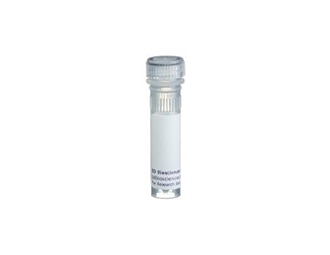Old Browser
Looks like you're visiting us from {countryName}.
Would you like to stay on the current country site or be switched to your country?


Regulatory Status Legend
Any use of products other than the permitted use without the express written authorization of Becton, Dickinson and Company is strictly prohibited.
Preparation And Storage
Product Notices
- Since applications vary, each investigator should titrate the reagent to obtain optimal results.
- An isotype control should be used at the same concentration as the antibody of interest.
- Caution: Sodium azide yields highly toxic hydrazoic acid under acidic conditions. Dilute azide compounds in running water before discarding to avoid accumulation of potentially explosive deposits in plumbing.
- For fluorochrome spectra and suitable instrument settings, please refer to our Multicolor Flow Cytometry web page at www.bdbiosciences.com/colors.
- Please refer to www.bdbiosciences.com/us/s/resources for technical protocols.
Companion Products


The 10/78 monoclonal antibody recognizes the rat CD161 proteins, CD161a (also known as, Klrb1a, or Nkrp1a/NKR-P1A), and CD161b (Klrb1b, Nkrp1b/NKR-P1B). These type II transmembrane glycoproteins have an extracellular C-type lectin domain and thus belong to the C-type lectin superfamily. These CD161 proteins form ~ 60 kDa homodimers that are expressed on natural killer cells and subsets of T lymphocytes, activated monocytes, and dendritic cells. The 10/78 antibody competes with the previously-described 3.2.3 antibody for binding to these CD161 proteins. CD161 molecules are C-type lectin-like receptors that can either activate (CD161a) or inhibit (CD161b) effector leucocyte responses, eg, cytotoxicity or cytokine production, against target cells which express C-type lectin-like related (Clr) molecules. Although several members of the Klrb1 gene family have been identified in the mouse and rat, only a single human KLRB1 homolog has been discovered.
Development References (13)
-
Bezouska K, Vlahas G, Horvath O, et al. Rat natural killer cell antigen, NKR-P1, related to C-type animal lectins is a carbohydrate-binding protein. J Biol Chem. 1994; 269(24):16945-16952. (Biology). View Reference
-
Bezouska K, Yuen CT, O'Brien J, et al. Oligosaccharide ligands for NKR-P1 protein activate NK cells and cytotoxicity. Nature. 1994; 372(6502):150-157. (Biology). View Reference
-
Chambers, W.H., Vujanovic, N.L, et al. Monoclonal antibody to a triggering structure expressed on rat natural killer cells and adherent lymphokine-activated killer cells. J Exp Med. 1989; 169:1373-1389. (Biology). View Reference
-
Fujimura T, Yang XF, Soriano R, Ogawa T, Kobayashi M, Jiang H. Cellular surface molecular and cytokine gene expression in rat heart allografts under optimal doses of cyclosporine and FK 506. Transplant Proc. 1998; 30(4):1023-1026. (Clone-specific: Immunohistochemistry). View Reference
-
Josien R, Heslan M, Soulillou JP, Cuturi MC. Rat spleen dendritic cells express natural killer cell receptor protein 1 (NKR-P1) and have cytotoxic activity to select targets via a Ca2+-dependent mechanism. J Exp Med. 1997; 186(3):467-472. (Biology). View Reference
-
Kirkham CL, Carlyle JR. Complexity and Diversity of the NKR-P1:Clr (Klrb1:Clec2) Recognition Systems. Front Biosci. 2014; 5(5):1-16. (Biology). View Reference
-
Kraus E, Lambracht D, Wonigeit K, Hunig T. Negative regulation of rat natural killer cell activity by major histocompatibility complex class I recognition. Eur J Immunol. 1996; 26(11):2582-2586. (Clone-specific: Immunoprecipitation). View Reference
-
Lanier LL. Natural killer cells: from no receptors to too many. Immunity. 1997; 6(4):371-378. (Biology). View Reference
-
Ryan JC, Niemi EC, Nakamura MC, Seaman WE. NKR-P1A is a target-specific receptor that activates natural killer cell cytotoxicity. J Exp Med. 1995; 181(5):1911-1915. (Biology). View Reference
-
Scriba A, Grau V, Steiniger B. Phenotype of rat monocytes during acute kidney allograft rejection: increased expression of NKR-P1 and reduction of CD43. Scand J Immunol. 1998; 47(4):332-342. (Biology). View Reference
-
Scriba A, Schneider M, Grau V, van der Meide PH, Steiniger B. Rat monocytes up-regulate NKR-P1A and down-modulate CD4 and CD43 during activation in vivo: monocyte subpopulations in normal and IFN-gamma-treated rats. J Leukoc Biol. 1997; 62(6):741-752. (Biology). View Reference
-
Trinite B, Voisine C, Yagita H, Josien R. A subset of cytolytic dendritic cells in rat. J Immunol. 2000; 165(8):4202-4208. (Biology). View Reference
-
Webster GA, Bowles MJ, Karim MS, Wood RF, Pockley AG. Activation antigen expression on peripheral blood neutrophils following rat small bowel transplantation. NKR-P1 is a novel antigen preferentially expressed during allograft rejection. Transplantation. 1994; 58(6):707-712. (Biology). View Reference
Please refer to Support Documents for Quality Certificates
Global - Refer to manufacturer's instructions for use and related User Manuals and Technical data sheets before using this products as described
Comparisons, where applicable, are made against older BD Technology, manual methods or are general performance claims. Comparisons are not made against non-BD technologies, unless otherwise noted.
For Research Use Only. Not for use in diagnostic or therapeutic procedures.
Report a Site Issue
This form is intended to help us improve our website experience. For other support, please visit our Contact Us page.